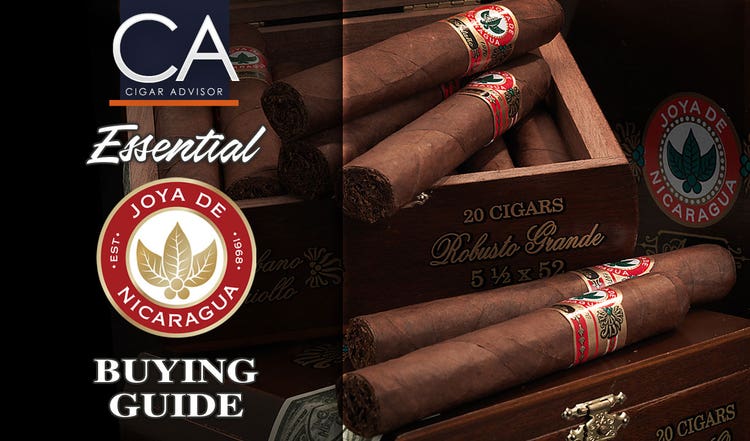
2019 CA Report: The Essential Cigar Advisor Guide to Joya de Nicaragua Cigars
CIGAR ADVISOR’S ESSENTIAL JOYA DE NICARAGUA CIGARS TASTING & BUYING GUIDE
Editors/Reviewers: Jared Gulick, Gary Korb, John Pullo, Tommy Zman Zarzecki
The Joya de Nicaragua Cigars Back Story
“It’s lifeline, it’s struggle, it’s will to forge ahead and renew, renew, renew, it’s Nicaragua itself.” That’s how Joya de Nicaragua describes its 50-plus years of making Nicaragua’s first and foremost premium cigar brand.
Founded in 1968 by Simón Camacho and Juan Francisco Bermejo, like many of their Cuban peers, they left the hardships of Communism to find new opportunities. For them it was Nicaragua where the volcanic soil was rich in minerals and the weather was ideal for growing tobacco. Based in Estelí, they set up the company under the name of the Nicaraguan Cigar Company.
Two years later, the Nicaraguan Cigar Company was becoming recognized in the United States as a popular alternative to the embargoed Cuban cigars. At the time, Anastasio “Tachito” Somoza DeBayle was the President of Nicaragua. Upon visiting the White House in 1970, Somoza was offered a box of Nicaraguan Cigar Company cigars by President Richard M. Nixon. Somoza, who owned tobacco farms in Estelí and Jalapa, also recognized the value of Nicaraguan tobacco – and so, he bought the factory.
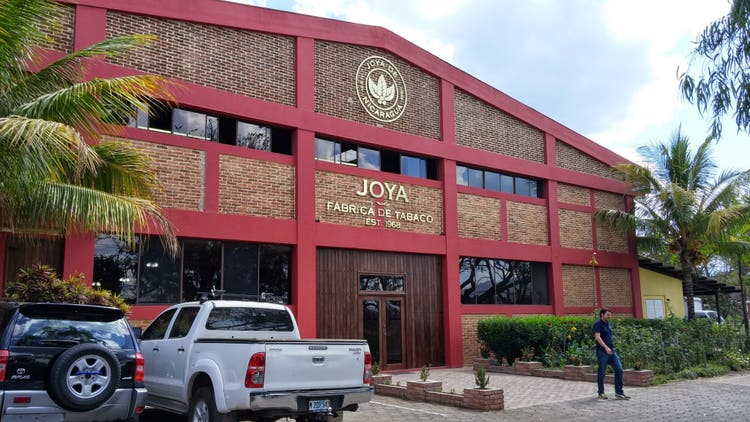
By 1979, Nicaragua was in the midst of a civil war. The Sandinistas, led by Daniel Ortega, revolted against the Somoza regime. Knowing the NCC factory was owned by Somoza, the revolutionaries tried to burn it down. After that, believing the Sandinistas were using the cigar factory as a base, pilots loyal to Somoza flew over the factory and bombed it – on Somoza’s orders!
The workers rebuilt the NCC factory in 1980 and cigar production resumed. By 1985 Daniel Ortega became president, and similar to what happened in Cuba, all businesses, including tobacco were nationalized. Moreover, the U.S. placed an embargo on all Nicaraguan goods, putting a chokehold on the Nicaraguan tobacco industry until being lifted in 1990.
It wasn’t until 1992 that a new era was ushered-in for Joya de Nicaragua. Enter Dr. Alejandro Martinez Cuenca. An economist and a well-liked member of the Sandinista party, Cuenca recognized the value of the Joya de Nicaragua brand and agreed to an initial 12-month trial rental of the factory.
With some help from investors, in 1994, Dr. Cuenca bought back the company and changed the name to Tabacos Puros de Nicaragua. However, when Somoza left Nicaragua, he took with him the trademark papers for the Joya de Nicaragua cigar in the U.S. and sold them to the highest bidder. So, one of the first orders of business for Dr. Cuenca was getting the rights back to the Joya de Nicaragua brand. His timing couldn’t have been better, since, with the cigar boom in full swing, consumer demand was growing for the heartier flavor of Nicaraguan tobacco.
By 2012, Dr. Cuenca’s son, Juan Martínez, was also working for the company. Together they continued to build the brand’s prestige by working much more closely with both their distributors and cigar consumers worldwide. They also expanded the brand’s reach by introducing the JOYA line, revamping the Clásico selection, and launching a new stable of Antaño cigars. By doing so, Joya de Nicaragua could market cigars to satisfy cigar smokers of every taste preference.
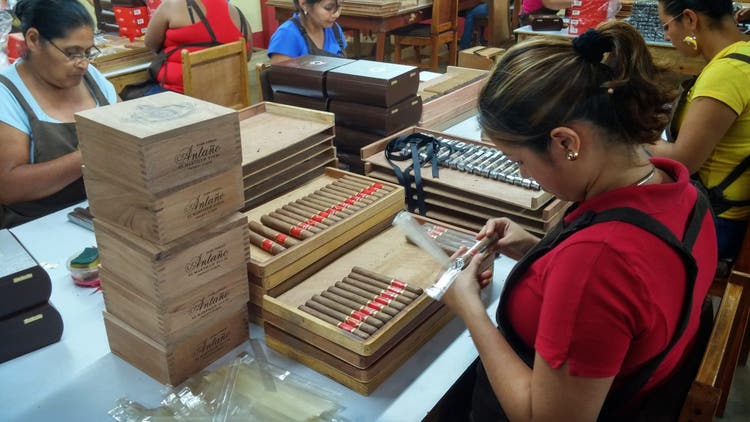
Punctuated by the release of the Joya de Nicaragua Cinco Décadas cigars, 2018 marked Joya de Nicaragua’s 50th anniversary. Reporting on the golden milestone Tobacco Business magazine wrote: “Joya de Nicaragua is much more than just a company with a product–it’s history, it’s a lifestyle and one could go so far to say that it’s the pulse of an entire country.”
Dr. Cuenca would certainly agree with that. As he put it: “What matters to me is that this brand has been the force through which the people of the factory have helped shape the history of Nicaragua itself.”
For this Joya Tasting Guide, we’ve sampled their way through the current production lineup of Joya de Nicaragua cigars available at Famous Smoke Shop…that’s a dozen in all; we start with the more recent special edition and anniversary cigar releases, and dig into the core lines from there. The results of our taste tests offer our basic impressions of each cigar, in some of the more popular sizes. As we always say, reviews are subjective and palates will vary, but these quick looks will give you a basic idea of how each cigar performed, and whether it’s the right Joya for you. And if you’ve already smoked them – or have a favorite – tell us what you like about any of these Joya de Nicaragua cigars by leaving a comment at the end.
Joya de Nicaragua Cinco Decadas Cigar Review
Size: Diadema (6” x 54 Perfecto)
Strength: Medium (listed Full)
Wrapper: Nicaragua
Binder: Nicaragua
Filler: Nicaragua
Construction: Utterly gorgeous and perfectly symmetrical, JdN is really showing off the talent of their torcedores here. Its outer plumage is oily, rosewood in color, and features a seamless roll and precision cap placement, making it clear that they put a lot of heart into the cigar.
Draw: Consistent.
Pre-light flavor: Woody and sweet.
Toasting & Light: Spicy.
Base flavors: Earth, bread, spices, and a slight sweetness.
Retrohale: Eye-watering and peppery.
Aroma: Fresh-baked bread and toast.
Burn & Ash Quality: The burn line is thin, and the ash holds extremely well. I have to hand it to JdN on this front, their construction is second to none.
Balance of flavors: On the nose.
Summary: For their landmark 50th Anniversary, Joya de Nicaragua wanted to craft a blend that stood above the rest. Juan Martinez was quoted as saying, “This is, without a doubt, the most spectacular cigar to ever come out of Joya de Nicaragua.” Those words look great on paper, but does the cigar stand up to it? Let’s find out.
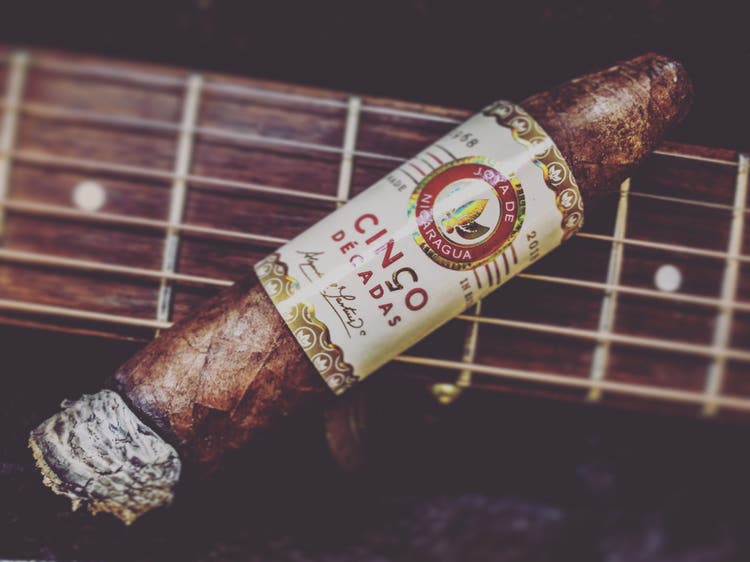
A sweet, oaky note was my pre-light perception on the tongue, and this gave way to spicy flavors within the first few puffs. As the cigar settled in, the aroma shifted to fresh baked bread laced with swaths of earth, leather, and spices. There’s a whisper of sweetness that lasts throughout the smoke, and I’m noticing a pattern of static flavors throughout all of my samples. There’s no real complexity, and if you like single-act cigars, this assuredly is a brand for you.
While its price point is on the high end, it’s meant to serve as a ceremonial cigar, one that you enjoy only on special occasions. The experience is pleasant, and medium in body across the board, but it does give the parting gift of a decent nicotine buzz if that’s the box you want check-marked. If you want to make an impression, this cigar will certainly turn every head in the room. – Jared Gulick
Joya de Nicaragua Cuatro Cinco Reserva Especial Cigar Review
Size: Torpedo (6” x 52 Figurado)
Strength: Full
Wrapper: Dark Habano (Nicaragua)
Binder & Filler: Nicaragua
Construction: Seamlessly rolled. Wrapper has an even, dark brown hue with a glint of red brick.
Draw: Finicky.
Pre-light flavor: Leathery.
Toasting & Light: Easy.
Base flavors: Earth, coffee, sweet spice, dark chocolate, light pepper.
Retrohale: Creamy and earthy.
Aroma: A mix of earth and mocha.
Burn & Ash Quality: Very good. Burn is consistently even, while ash is mostly grey and very firm.
Balance of flavors: Excellent.
Summary: This all-Nicaraguan magnum opus was released for Joya de Nicaragua’s 45th anniversary and continues to be one of the brand’s most highly sought-after blends. Made in three sizes, the Torpedo is among the more formidable-looking in the line with its 52 ring and tapered head. A leathery pre-light taste gives way to early notes of earth, roasted coffee and a ripple of sweet spice upon lighting.
The overall construction of the cigar was excellent, but I had some problems with the draw on this sample. It eventually opened-up enough to provide additional flavors of dark chocolate (a la 90% cacao) and a little more sweetness.
The retrohale was impressively creamy with a mostly earthy flavor; not the pepper I expected, but it did have a more peppery residual in the latter stages, including the finish.
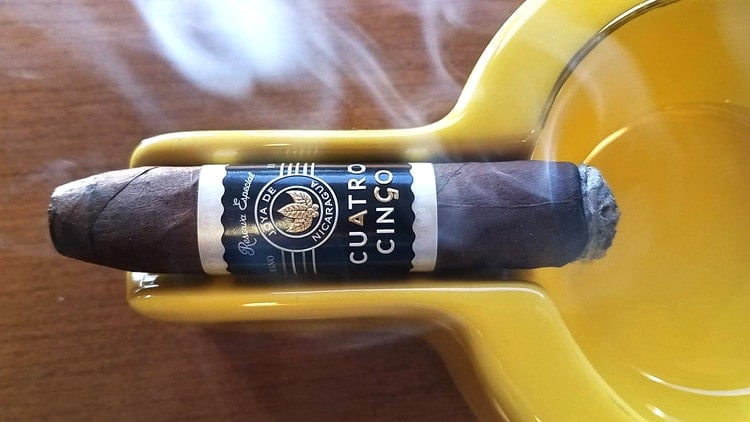
For the most part, the flavors were well balanced and held fairly tightly together for an earthy and semi-sweet mix of flavors. Earth, roasted coffee, and dark chocolate were more prevalent in the final stages as this cigar wrapped-up at my one-inch nub.
The Cuatro Cinco is undoubtedly suited for more experienced palates, and when paired with a good bourbon or dark rum will reveal even more savory subtleties. Moreover, this blend is more accessible to smokers who don’t want the perpetual boldness of an Antaño 1970. – Gary Korb
Joya de Nicaragua Antaño 1970 Cigar Review
Size: Robusto Grande (5 1/2” x 52)
Strength: Full
Wrapper: Nicaraguan Criollo
Binder: Nicaragua
Filler: Nicaragua
Construction: Oily, dark brown wrapper with an indelible rolling line and two turns to its sturdy cap. I used a V-cut twice to get a cross cut and it held up perfectly.
Draw: Easygoing.
Pre-light flavor: Very spicy and peppery on the tongue.
Toasting & Light: Chocolaty and nutty.
Base flavors: Cocoa, leather, a slight sweetness, and some pepper.
Retrohale: Notes of cherries and plenty of pepper.
Aroma: Peppery, nutty, and pleasant.
Burn & Ash Quality: My sample burned a bit wonky at times, but nothing drastic. The ash was firm and stayed in place.
Balance of flavors: Excellent.
Summary: In Spanish, Antaño means yesteryear, and nostalgia is the precise emotion that Joya de Nicaragua intended to evoke. As a tribute to the powerful Nicaraguan blends that were prominent on the 1970s post-embargo market, Antaño is meant to serve as a time machine to bring those puro flavors back. Since its release, the cigar has become a legend of its own, both on the merit of its flavor and strength. It’s the kind of smoke that your buddies dare you to have on an empty stomach. Don’t do that.
The pre-draw flavor was spicy and stinging on the tongue, and toasting gave way to an aromatic waft of chocolate and nuts, some which were evident in the first few puffs. I received leather, cocoa, pepper, and a faint sweetness, but things at that point were unnervingly tame and remained that way through the first inch or two. Where was all of its infamous, devilish power?
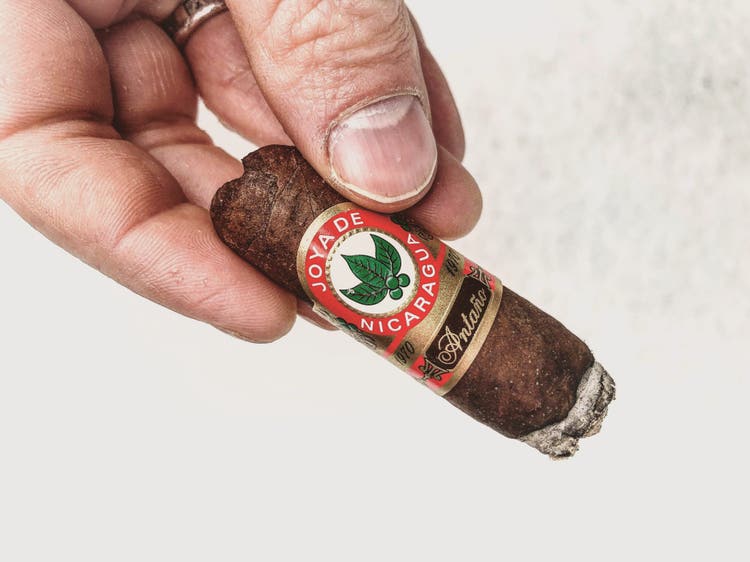
Most strong sticks catch you in the gut, but about a third of the way in, this one hits you in the head with a sensation similar to an alcohol buzz. Retrohaling gave notes of cherries, plenty of pepper, and left a tingling sensation lingering on the roof of my mouth.
With its rear-loaded profile, Antaño 1970 will sneak up on you if you are unprepared. It drips with decadent and savory flavors and is undoubtedly delicious, but it’s not for the faint of heart. It’s perfect for anyone who wants unbridled strength, and it should probably come with a sticker and a lollipop for anyone who makes it all the way through. – Jared
Joya de Nicaragua Antaño 1970 Gran Reserva Cigar Review
Size: Belicoso (6” x 54)
Strength: VERY Full
Wrapper: Nicaraguan Habano Criollo
Binder: Nicaragua
Filler: Nicaragua
Construction: Solid.
Draw: Excellent.
Pre-light flavor: Earthy sweetness.
First Few Puffs: Peppery.
Base flavors: Pepper, nuts, dark chocolate, natural sweetness.
Aroma: Earthy.
Burn & Ash Quality: Very solid.
Balance of flavors: Perfect balance from a very experienced roller.
Summary: This cigar truly kicks ass… end of review. Ok, I guess I am paid to tell you a bit more and I’ll do so gladly because I really love this stick. It was the #16 Cigar of the Year in 2018 and could have easily cracked the top 10. If you’re wondering what the difference between the Gran Reserva and the original 1970 Antano is – well, the original is like an 800 lb. Silverback gorilla smashing your face with a bunch of bananas. The newer offering is more like the same primordial beast in a tuxedo, knocking back a single malt, neat, while listening to Sinatra.
The outer leaf is a dark chocolate brown Nicaraguan Habano Criollo, with Nicaraguan filler that’s been aged for five full years, and that makes for a whole lotta flavor. Up front there’s a shot of pepper, but that gives way less than a half inch in as very dark, bitter chocolate and nuts come into play, which is a wonderful dessert-like gift to the palate. All the way though you’ll experience a pleasant smack of sweetness from that dark and toothy wrapper.
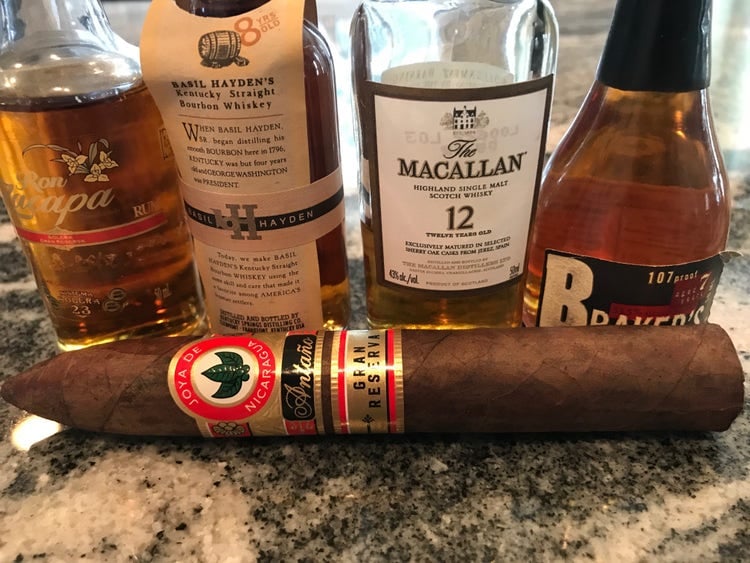
The cigar itself is solid as a rock but draws perfectly due once again to the excellent construction from the people at Joya. As for the drink pairing for this puro primate, Scotch, Bourbon or Rye – there’s no wrong answer as any good brown liquor will suffice (I went Balvenie Doublewood). If you’re a fan of dark n’ full, your delicious powerhouse has arrived. – Tommy Zman Zarzecki
Joya de Nicaragua Antaño Dark Corojo Cigar Review
Size: El Martillo (5 ½” x 54 Robusto)
Strength: FULL
Wrapper: Nicaraguan Corojo Oscuro
Binder: Nicaragua
Filler: Nicaragua
Construction: A well-rolled, oversized robusto with a coffee bean-colored Corojo wrapper, and just a bit of oily sheen.
Draw: Clear.
Pre-light flavor: Raisins, wood, barnyard and fear. Also, a faint smell of coffee.
First Few Puffs: Spice, espresso and molasses.
Base flavors: Earth, leather, dried fruit and chocolate.
Retrohale: Pepper, dark roasted coffee.
Aroma: Combo of barnyard and earth.
Burn & Ash Quality: Ragged and wavy burn; nearly-white ash is a little flaky and doesn’t hold long. Needs relights, as this Joya is loaded with so much thick, dark and heavy tobacco.
Balance of flavors: The Antaño Dark Corojo is not wildly complex, but the flavors are very developed and intense – which matches the intensity of the cigar.
Summary: Ah, this thing of cigar lore…the strongest cigar in the Joya de Nicaragua lineup, renowned for the uber-full intensity of its locally cultivated leaves. It is Ligero a-go-go, and even JdN plays it up by giving this Antaño Dark Corojo’s Robusto the name El Martillo, which means “the hammer.” Really, this is what is known as Doble Fuerte: double strong, and even the Joya folks say you should only smoke it on a full stomach. So I heeded their warning, ate a huge lunch, and I’m going for it.
It turns out that the Joya de Nicaragua Antaño Dark Corojo is actually smooth and refined…Right away it’s giving up thick, full smoke with a taste of heavily fermented tobacco, molasses, and leather. And just like that, the shift is on – a bit of a tangy liqueur taste, balanced with earth. Once you get past the first inch, you think all this talk about this Joya being strong is overblown. But it’s a sneaky little number, and slowly ramps up, mostly without you noticing. It’s not intensely peppery, or wildly spicy – it is fat, juicy and FULL like a center cut pork chop. The smoke lends sweet and tangy flavors, and bangs away at these savory notes like a fat-handed pianist.
It’s also starting to taste strong – and just when I think this thing is going to roll me and leave me for dead, it turns on some charm: that earthy, leathery base note is punctuated with dried fruit and dark chocolate, but it’s still enough to give me the burps. This big-boned Joya has a super long finish that keeps the taste buds watering, and leaves a lump in the back of the throat. I guarantee you, the nicotine will leave a bubble in your stomach.
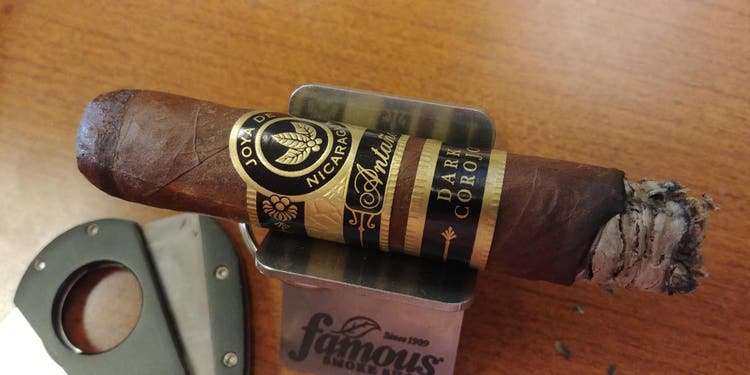
The closer you get to the nub of a cigar this strong and relight it, the more likely it is to come back and bite you. But I figured with these kinds of good flavors, a little brinksmanship was in order – to see how close to the line I can get, without going over. Glad to say, it’s consistent to the end…and over two hours after I started, it was time to let this slow-burning toughie go.
A lot of people make this Joya out to be a power smoke extraordinaire, pillaging your taste buds and burning with all the subtleties of a baseball bat to the gut. Yeah, it’s full, but this Joya is certainly manageable – even if you’re not a nuclear hot wings kind of guy. Of course, no good cigar is made to cause you pain or discomfort, nor are any medals awarded for your smoking feats of strength – so if you’re part of the full-bodied (say, LFD and La Bomba) crowd, but want less spice/thicker flavor – cross over and smoke this cigar – especially if you don’t have to be anywhere for a while. – John Pullo
Joya de Nicaragua JOYA Cabinetta Cigar Review
Size: Robusto (5” x 50)
Strength: Medium
Wrapper: Ecuador Connecticut/Nicaraguan Criollo
Binder: Nicaragua
Filler: Nicaragua
Construction: Obvious feature is the eye-catching dual wrapper, a light caramel Connecticut against a milk chocolate Criollo. Rolled straight, heavy and well packed.
Draw: Slight bit of resistance.
Pre-light flavor: Fruit zest, nuts, barnyard.
First Few Puffs: Salty-sweet, tangy, a little tweak of spice that gets the inside of the cheeks tingling.
Base flavors: Toasted nuts, wood, dry spice, cocoa.
Retrohale: Natural tobacco sweetness, with a toasty hint of pepper that gets more intense later on.
Aroma: Warm and sweet.
Burn & Ash Quality: A mostly even burn leaves behind a stacked salt n’ pepper ash.
Balance of flavors: More complex than I expected.
Summary: At the Joya de Nicaragua factory, the Cabinetta is what’s called a Dos Capas (“two wrappers”) cigar. BUT – the Connecticut leaf actually wraps the entire cigar, while the Criollo is actually placed on top of the Connecticut for the last one-third or so. It’s designed so that when that Criollo kicks in, you get a new set of heartier, more intense flavors to bring you down the home stretch. Because at the end, you’re smoking two wrappers at once (not unlike a barber pole cigar) – and should, theoretically, get the best flavors of both worlds: the creaminess of the Connecticut, laced with the spice of the Criollo – but without making the cigar too strong. You might (or might not) even notice a bit of zest off the Criollo leaf as it touches your lips, even before you get to smoking that far down.
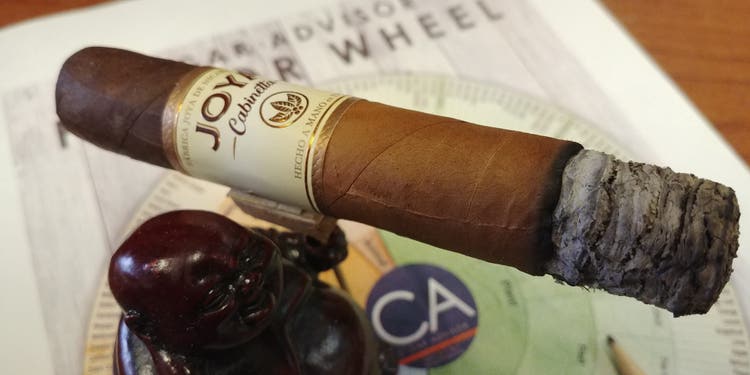
The smoke is a bit on the thin side to start, with a mellow, straightforward vibe that’s sweet with a bit of berry. By 1/3, that tanginess gets a little tart; saltiness gets in there, as does wood and a pinch of dry spice. The Joya Cabinetta has now matured into a mostly straightforward smoke handing out nuts, wood and a bit of leather. The smoke fattens up with a cool, thick and creamy feel, now that all the parts are humming – and at halfway through, along comes a fruit acidity that’s very much like the taste left behind after you take a swig of black coffee with a little sugar.
It’s about now that we’re approaching the Criollo layer…the taste gets very tangy and more peppery, though I’m not sure if this is just anticipation building. Then it crosses over into the darker wrapper – it’s not fireworks, but there is a noticeable transition to the profile: the smoke is very thick and creamy, and the sweetness of cocoa powder lands square on the taste buds – and everything finishes with a zesty taste.
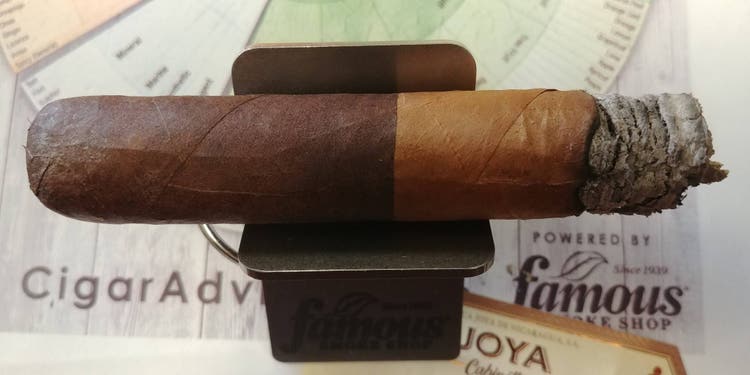
You deserve to know that I am coming from somewhat of a biased position, as I am a huge fan of the Joya Cabinetta – mostly because I can get some nice “Nicaraguan” flavors without the punishing effects of steep nicotine portions. Those flavors may not be wide ranging, but the intensity with which they come and go is what makes this Joya de Nicaragua selection very attention-getting. So if you prefer to fill your cigar time with something less aggressive, it’s nice to know that it doesn’t mean Joya de Nicaragua is off limits to you – and the JdN Cabinetta is proof. – John
Joya de Nicaragua JOYA Red Cigar Review
Size: Toro (6” x 52)
Strength: Medium
Wrapper: Habano (Nicaragua)
Binder & Filler: Nicaragua (Estelí, Condega, Jalapa)
Construction: The cigar seamlessly rolled showing no soft spots. A darker, mottled color on this sun grown wrapper gave the cigar an attractive two-tone, dark brown/brick red appearance.
Draw: Excellent. Smoke drew easily with plenty of volume from start to finish.
Pre-light flavor: Raisins.
Toasting & Light: Foot takes quickly to flame for an even toasting and light.
Base flavors: Cashews, sweet spices, raisin, vanilla toffee.
Retrohale: Mostly mellow with a hint of pepper.
Aroma: Sweet.
Burn & Ash Quality: Cigar burns evenly throughout exposing very firm, light grey (almost white) ashes.
Balance of flavors: Excellent.
Summary: JOYA Red has become one of my regular “go-to” cigars in the line, especially as a first cigar of the day. The smoke is medium in body offering plenty of rich, chewy smoke. Well-rounded notes of earthy spice, oak, and sweet cream open the first act and eventually transition to flavors of cashews, raisins, and a hint of vanilla toffee.
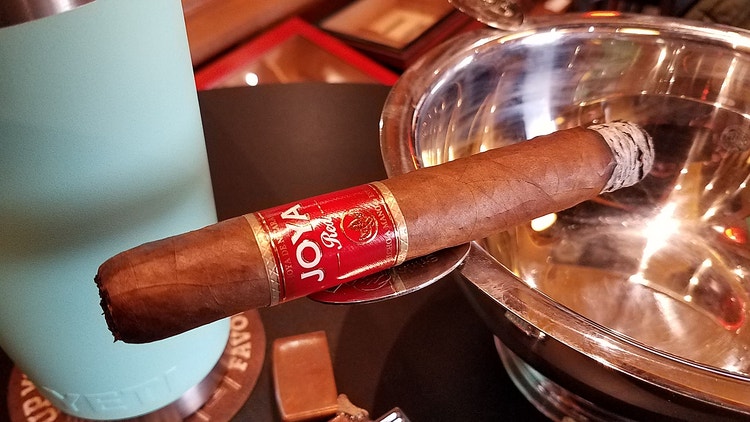
At the cigar’s midpoint, caramelized flavors of cashew, nutmeg, raisin, and vanilla toffee locked-in for a well-balanced mix that went perfectly with my coffee while giving the cigar excellent consistency throughout. Even in the final inches, the smoke remained medium-bodied and creamy with a long finish.
As noted with regard to the Cunning by JdN selection (below), newer smokers will also find JOYA Red a tasty entry to the Joya de Nicaragua brand. It’s got more flavor and body than Cunning due to its Habano wrapper, which also brings it a little closer to Joya’s more full-flavored blends. So, for those who start with the Cunning, JOYA Red is the logical follow-up; otherwise, Red will get you to Joya de Nicaragua nirvana that much sooner. – Gary
Joya de Nicaragua JOYA Black Cigar Review
Size: Robusto (5 ¼” x 50)
Strength: Medium
Wrapper: Mexican San Andres
Binder: Nicaragua
Filler: Nicaragua
Construction: Rough looking leaf, thick and leathery with the color of a Brazil nut (those weird shaped things in the nut bowl that no one ever eats, so I know you know what it looks like); you’ll also notice plenty of tooth.
Draw: A bit tight.
Pre-light flavor: Meaty, mint and dried fruit, barnyard.
First Few Puffs: A shot of pepper gives way to general meatiness.
Base flavors: Dried fruit, plus hints of cedar and coffee.
Retrohale: Slightly sweet, with wood and spice.
Aroma: A little nutty, a little sweet.
Burn & Ash Quality: You’re not likely to get a picture-perfect burn out of this leaf, but it hangs in there without needing any maintenance. Near-white ash, some light flaking.
Balance of flavors: Intensity of flavor, as opposed to strength, is this Joya’s bright spot.
Summary: The first JdN in a San Andres wrapper, this Joya Black was designed to smoke fat and delicious without overpowering. According to Joya de Nicaragua factory manager Mario Perez, “We have had these wrappers available for some time and we wanted to create a blend with rich Nicaraguan tobacco, yet without the overpowering strength. The result is a balanced, rich and pleasant smoking experience.”
It’s a bit of a mouthful to start: the draw opens up, producing fat rips of thick, creamy smoke that are filled with tastes of coffee, charred wood, and a bit of a pepper shot that’s gone as quick as it arrives; that pepper is soon replaced by a slight spice that hangs on for a long finish. Earth and leather nudge their way forward, and the smoke takes on a “heavy” feel that leaves a bubble in the back of your throat. It’s right around now that you notice how the Joya blenders have tweaked the dials, and why this Joya Black lands a notch higher on the intensity meter than the Joya Red. There’s a tiny bit of sweet – and I do mean tiny. Like a dried fruit taste (think raisins).
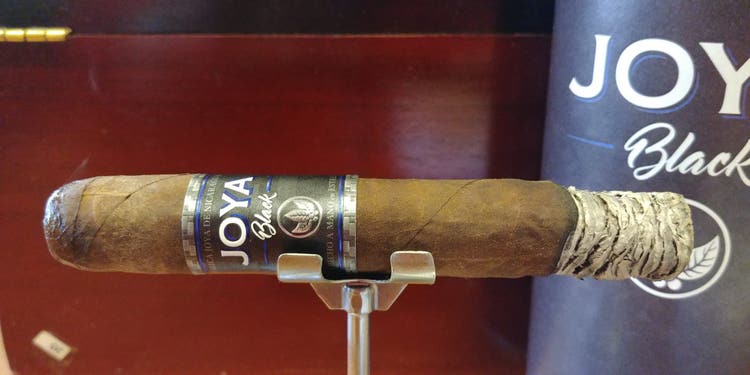
What I like is how the San Andres wrapper plays nice with the Nicaraguan tobaccos inside, and the flavors mesh together really nice. Others have noticed, as this Joya cigar has earned plenty of points from both Cigar Journal and Aficionado, and landed in the both of their Top 25 lists for 2017. So there’s that.
Ratings are what they are, and maybe they don’t matter to you…but I think this suggestion will: if you enjoy a San Andres Maduro like MUWAT, Undercrown or even Saint Luis Rey, but want to shift into something a little more niche – this Joya Black is a good direction for you to go next. – John
Joya de Nicaragua JOYA Silver Cigar Review
Size: Toro (6” x 52)
Strength: Medium to Full
Wrapper: Ecuadorian Habano
Binder: Mexican San Andres
Filler: Nicaragua
Construction: EXTREMELY well-made cigar.
Draw: Amazing.
Pre-light flavor: Nuttiness.
First Few Puffs: Cherry-like sweetness.
Base flavors: Spice, dark coffee bean, citrus, cherry.
Aroma: VERY toasty.
Burn & Ash Quality: Slightly flaky.
Balance of flavors: Flavors shift nicely.
Summary: The Silver is one hell of a gorgeous looking cigar, box-pressed, oily, dark, and smooth as a silk smoking jacket. I swear, I wanted to yank the entire top row from the box and smoke them all at once! The pre-light taste and aroma when putting the foot to your nose has a very pleasant sweetness and almost a tad floral.
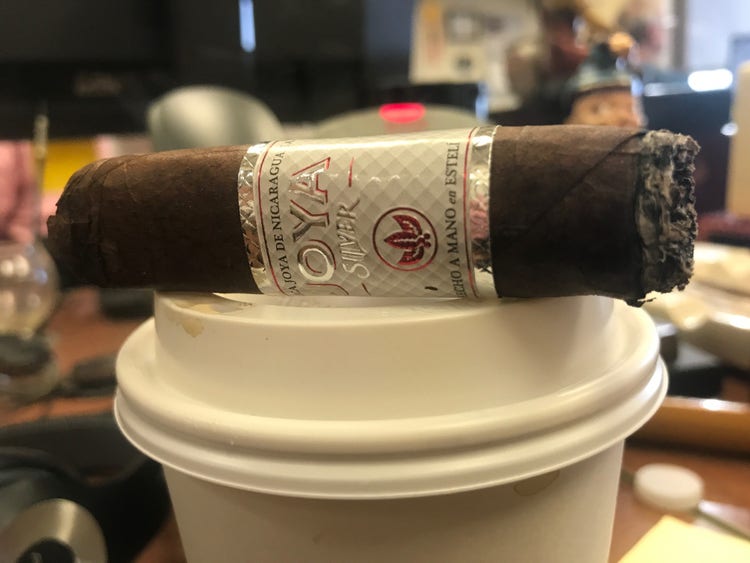
Immediately within the first few puffs there’s a medium-bodied sweetness reminiscent of dark cherries, and then that coffee bean flavor starts to build. As the cigar burns, a spiciness sets in as well, slowly pushing this stick to the full-bodied side (a result of the Mexican binder coming into play). Showing off its complexity, a citrus element turned up for me in the final third, which really capped off the experience. Well, then there’s the Tawny Port wine and espresso I paired with it that ramped up the pleasure scale even that much more.
Now, I’m telling you that this is also one incredibly well-constructed cigar, very firm with a perfect draw that produces an absolute ton of thick smoke. What I really noticed was how cool the smoke felt in my mouth due to the box-pressed shape, no doubt. I feel that this is a perfect after dinner smoke, and it’s priced quite nicely for a premium of this quality. – Tommy Zman
Cunning by Joya de Nicaragua Cigar Review
Size: Toro (6” x 50)
Strength: Mellow-plus
Wrapper: Connecticut Shade (Ecuador)
Binder & Filler: Nicaragua
Construction: Well-built with a silky blonde wrapper finished with a two seam cap.
Draw: Very good.
Pre-light flavor: Faint hint of cedar and leather
Toasting & Light: Toasts nicely. Foot takes quickly to flame and lights evenly.
Base flavors: Cedar, cream, roasted nuts, sweet tobacco, white pepper.
Retrohale: Mellow and creamy. (No specific flavors.)
Aroma: Sweet.
Burn & Ash Quality: Burn is spot-on even, exposing a very firm, white marble ash. The first ash was 2-inches until it succumbed to gravity, revealing a perfect cone.
Balance of flavors: Perfect.
Summary: The Cunning selection is one of the most accessible in the JdN stable, in that, newer cigar smokers can get a good sampling of Joya de Nicaragua’s rich Nicaraguan flavor without being overpowered. This Toro starts out spicy with a fair amount of white pepper up front. About an inch later, it transitions to a mix of creamy-nuttiness with some underlying sweetness. Crossing into the second act, the sweetness resumes, but some pepper notes return and linger on a rather dry finish. In the last act, the smoke is more medium-plus. The sweetness is pushed aside as earth, charred wood, and spice monopolize the mix.
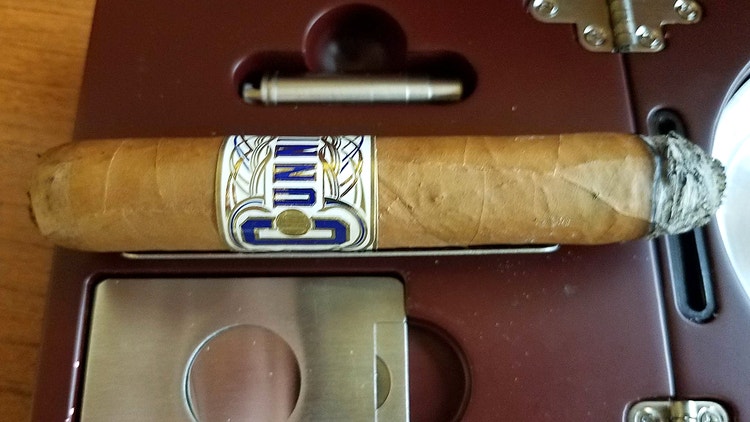
Cunning was pretty impressive for a “mellow” cigar. The smoke offered good volume throughout, and what I thought might be a mostly one-note song, turned out to be more of a medley as it switched gears from spicy, to woody, to creamy and back again.
All-in-all, a good morning or afternoon cigar, especially with coffee. As I alluded to above, Cunning is one of several good choices for getting into the JdN brand. And because Cunning is made exclusively for Famous Smoke Shop, you can get started at a nice price. – Gary
Merciless by Joya de Nicaragua Cigar Review
Size: Toro (6” x 50)
Strength: Medium (listed Full)
Wrapper: Ecuador Habano
Binder: Nicaragua
Filler: Dominican Republic
Construction: Milk-chocolate brown wrapper with some darker spots, a few protruding veins, and noticeable seams. The cap has a single turn and a small piece came off with my V-cutter.
Draw: Easy, smooth draw.
Pre-light flavor: Wood, earth, and traces of pepper.
Toasting & Light: An ultra-slight sweetness, with a warm dash of water chestnuts.
Base flavors: Earth, wood, leather, water chestnuts.
Retrohale: Smooth and hearty with a pinch of pepper.
Aroma: Sweet and oaky.
Burn & Ash Quality: The ash is very light grey and holds well, even when trying to knock it off.
Balance of flavors: The flavors are well balanced. The smoke is warm, hearty, and inviting.
Summary: Merciless serves as a budget cigar option from Joya de Nicaragua and is exclusive to Famous Smoke Shop. The introductory-level pricing gives value as it lets smokers enjoy some of the superb flavors for which JdN is known, without the sticker shock that you get with some of their higher-tiered premiums.
Aesthetically speaking, my sample was a bit rough around the edges. There were some noticeable veins, gaps in the wrapper seam, and only a single turn to the cap – which tore slightly upon the cut – all which are indicative of, and commonplace, with thrifty cigars. Aside from those issues, the rest of my experience was nearly flawless. The ash was so stable that I had to exert force to eject it, and it held like duct tape for the rest of my smoke.
The pre-light and first inch or so gave a prevalent note of water chestnuts with an oaky-sweet aroma. Its thick, heavy smoke provided a warm and comforting sensation that I associate with heartiness, kind of like a bowl of soup on a cold day.
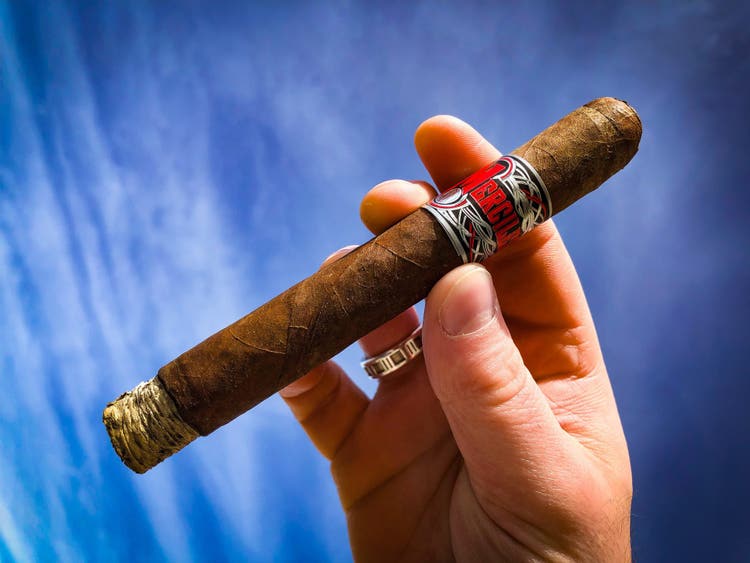
After the inch mark, flavors shifted to make for a leatherier and earthier profile. There was only a trace of pepper, and not much on the order of spices, but you could find them both on the retrohale and sprinkle it in as needed. A grassy sweetness also made its debut, and this was the extent of the cigar’s complexity.
Even though Merciless is listed as full-bodied, I found it to be on the low end of medium, and a fantastic jump-off point for working your way up the flavor ladder if you’ve recently completed cigar boot camp. There were some visual problems, but none of them impacted the taste. The lesson here is that how your cigar looks is not always a reflection of how much you’ll enjoy it. Good looks don’t mean anything on an inferior blend, and respectively, a rough look doesn’t detract if it’s delicious. Merciless was and I’d smoke it again, especially at its friendly price point, and I think I’d list it as my favorite of the group. It’s like your favorite pair of worn-in shoes – not the prettiest, but certainly the most welcoming. – Jared
Rosalones Reserva by Joya de Nicaragua Cigar Review
Size: Toro (6” x 50)
Strength: Medium
Wrapper: Nicaraguan Habano
Binder: Nicaragua
Filler: Nicaragua
Construction: A very well-made cigar.
Draw: Very smooth.
Pre-light flavor: Tobacco sweetness.
First Few Puffs: Just a little spicy.
Base flavors: Nuts, molasses, and spice.
Aroma: Toasty.
Burn & Ash Quality: Burned slow with a fairly solid ash.
Balance of flavors: Slightly complex with nice balance.
Summary: The people at Joya de Nicaragua are renowned for making full-bodied smokes (some are extremely full-bodied) filled with rich and hearty Nicaraguan tobacco. I hadn’t smoked a Rosalones before and was expecting the usual Joya heavy-hitter experience, but that’s not the case here. They’ve crafted a medium-bodied Nic stick that is very full-flavored but won’t light your beard on fire. It’s got a really nice autumn-brown colored wrapper with a pre-light draw that’s very sweet.
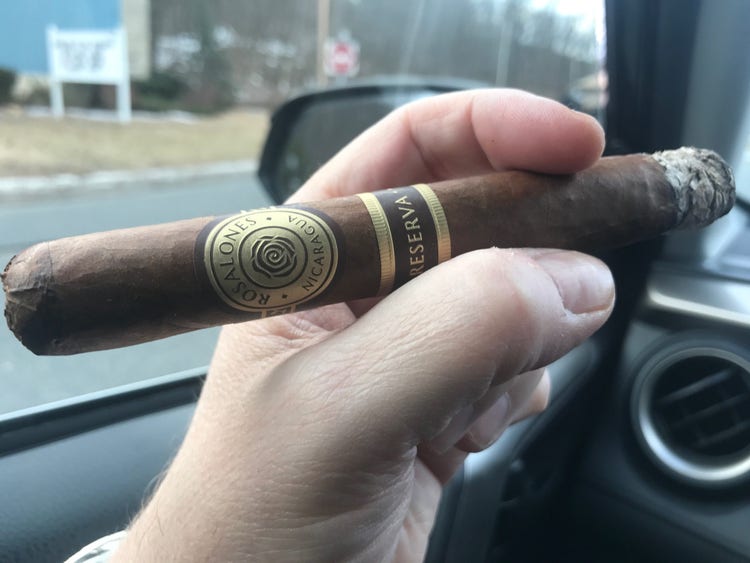
It’s a bit spicy right off the bat, and then suddenly – WHAM – I got hammered with the taste of molasses, which is not something I get in a lot of flavor profiles. That seemed to be dominant until around halfway through as a pronounced nuttiness then appeared, with both of these flavors carrying through the rest of the cigar. The retrohale was pretty zesty as that spice came right through. I’d have to say the profile was unusual, but very tasty.
Now the construction on this one is worth mentioning as every time I tapped the ash on my car window, it broke off perfectly squared, the sign of a well-rolled stick. The draw was smooth, producing a lot of smoke, and the ash grew back solid every time. I loved that this is medium bodied as the rich flavors went great with my morning coffee on my hour-plus commute. This is a very affordably priced cigar for a premium, making it one hell of a value as well. – Tommy Zman











